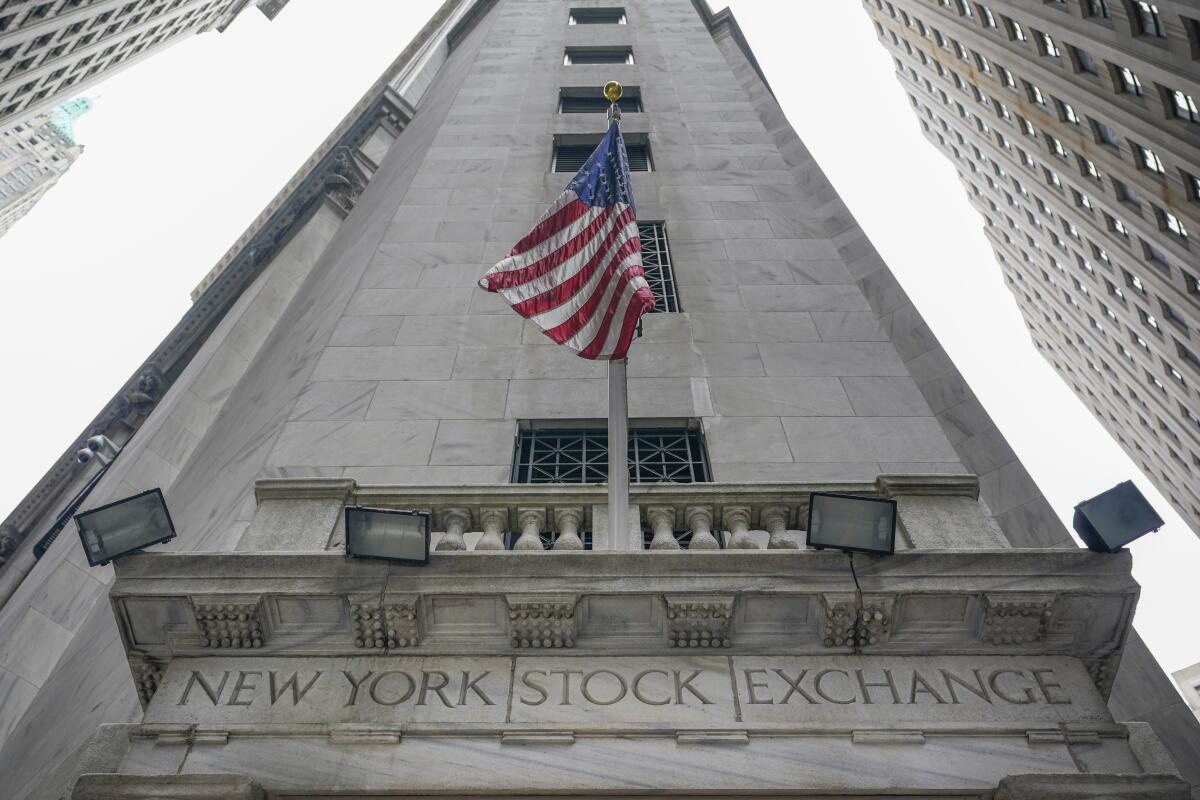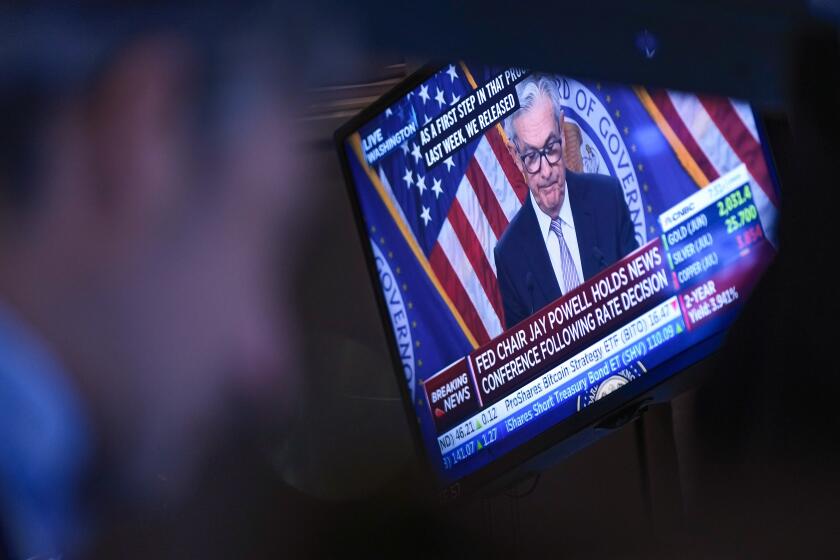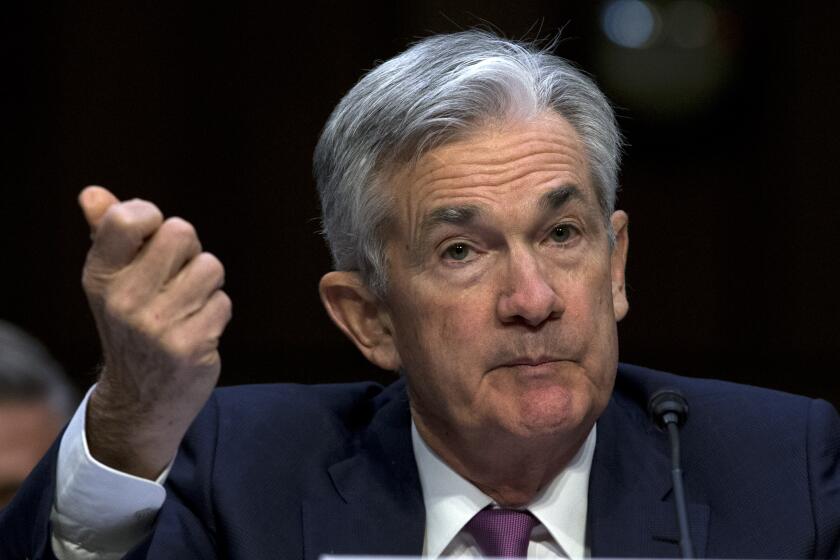Wall Street jumps, and its winning streak kicks into a higher gear

- Share via
Stocks swept higher Thursday, revving up the longest rally for Wall Street in a year and a half.
The Standard & Poor’s 500 rallied 1.2% to reach heights untouched since April 2022. The Dow Jones industrial average climbed 428 points, or 1.3%, while the Nasdaq composite rose 1.1%.
Home builder Lennar helped lead the S&P 500 with a gain of 4.4% after reporting stronger profit and revenue for the latest quarter than expected. It also gave a stronger-than-expected forecast for upcoming deliveries, saying customers are accepting the “new normal” of higher interest rates.
The stock market is still absorbing the Federal Reserve’s warning from a day earlier that it could raise interest rates two more times this year in its battle against inflation. It’s already hiked its benchmark overnight rate to the highest level since 2007, which has helped slow inflation somewhat but has also caused sharp pain in several areas of the economy.
The Federal Reserve kept its key interest rate unchanged Wednesday after having raised it 10 straight times to combat high inflation.
The Fed is trying to find the right level for rates where it can slow spending by Americans enough to get inflation under control but not so much that it causes a deep recession. Reports on Thursday offered a mixed picture of how it’s going.
But for a market that’s been relentlessly rising, that was enough to firm hopes that the Fed may end up raising rates only once this year and that the economy can skirt a painful recession.
“Today’s mixed economic data probably won’t provide much clarity for investors wondering what to make of the Fed’s mixed message from Wednesday,” said Mike Loewengart, head of model portfolio construction at Morgan Stanley Global Investment Office.
Treasury yields fell immediately after the reports. In the stock market, meanwhile, a wide range of stocks climbed to quell some criticism that this year’s rally has been due to only a handful of companies benefiting from the frenzy around artificial intelligence.
“The Fed remains data and event dependent, so investors globally will need to be so as well,” said John Vail, chief global strategist at Nikko Asset Management.
Thursday’s headline economic report showed that sales at U.S. retailers unexpectedly strengthened last month, when economists were forecasting a drop. That could be a sign that spending by consumers overall is holding up despite more expensive rates on credit cards and other loans.
Even Federal Reserve economists know that wages had no effect on inflation. But that doesn’t stop Fed Chair Jerome H. Powell from harping on labor costs and ignoring the real culprits.
But underneath the surface, the numbers were a touch weaker than expected after ignoring sales of autos, fuel and some other areas. Those numbers feed into the U.S. government’s estimates for the overall economy’s growth.
A separate report said slightly more workers applied for unemployment benefits last week than expected. Though the number is still relatively low compared with history, a tick higher could be a sign that a remarkably resilient job market is finally starting to loosen after the Fed’s barrage of rate hikes since early last year.
In manufacturing, the effects of higher rates have been more clear. The industry has been contracting for months, though it accounts for only a relatively small part of the economy.
One report Thursday said manufacturing activity in the mid-Atlantic region suffered its 10th straight month of contraction. Another, though, said sentiment among manufacturers in New York state unexpectedly improved this month.
Treasury yields slumped after the reports. The yield on the 10-year Treasury fell to 3.72% from 3.79% late Wednesday. It helps set rates for mortgages and other important loans.
Tech layoffs, bank failures and a potential U.S. recession could throw a wrench in the plans of 2023 graduates — in the same year federal student loan payments are expected to resume and accrue interest.
The two-year yield, which moves more on expectations for the Fed, fell to 4.64% from 4.69% late Wednesday.
Even though the Fed warned Wednesday that it may boost rates twice more this year, it also let a meeting pass without raising rates for the first time in more than a year. In another upside for markets, the Fed said it hasn’t made any final decision yet on whether to keep raising rates.
That helped the S&P 500 to close Thursday with a sixth straight gain, its longest winning streak since late 2021. The stock market has leaped nearly 24% since hitting a bottom last October, as the economy has so far avoided a recession and inflation has come down from its peak last summer.
The S&P 500 rose 53.25 points to 4,425.84. The Dow advanced 428.73 points to 34,408.06, and the Nasdaq climbed 156.34 points to 13,782.82.
Much attention is on the Fed’s next meeting, which will run July 25 and 26. The bet on Wall Street is that it will raise rates next month, but traders at the moment are mostly convinced that will be the last increase of the year, according to data from CME Group.
Before that meeting, relatively few high-profile economic reports will arrive that could sway the Fed’s thinking. Among them are the next monthly updates on the job market and inflation at the consumer level. Companies will also begin reporting in early July how much profit they made during the spring.
The Fed isn’t alone in keeping the pressure up on interest rates to battle inflation. The European Central Bank raised rates Thursday and pledged more may be on the way, including at its next meeting in July.
Asian stocks were mixed. Chinese indexes rose amid hopes for more stimulus from China’s central bank as the recovery from anti-COVID restrictions for the world’s second-largest economy stumbles. Such hopes also boosted prices for crude oil by more than 3%.
AP writers Yuri Kageyama and Matt Ott contributed to this report.
More to Read
Inside the business of entertainment
The Wide Shot brings you news, analysis and insights on everything from streaming wars to production — and what it all means for the future.
You may occasionally receive promotional content from the Los Angeles Times.













